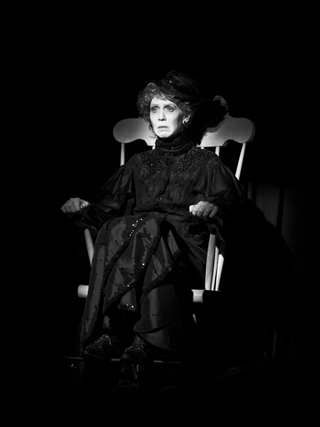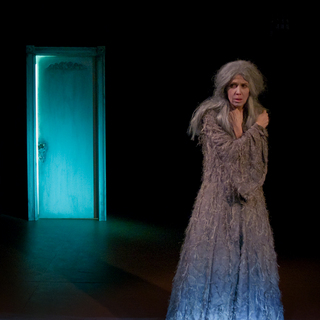Two Haunting Tales
By Keith Vance
February 28, 2009
Beckett's "Rockaby" is less than 15 minutes long, but it's mesmerizing. Like Findley's avant-garde films, it lulls the audience into a trance as they watch an old woman, played superbly by Mary Ewald who wears a black-sequined gown and rocks back and forth, "to and fro," as the narrator, also Ewald, draws on the memories of the woman's life. When the pre-recorded narrator pauses, Ewald's character with "famished eyes" pleads "More." And so it goes, each time the narrator pauses, "More" prods the old woman until there is no more. No more memories. No more life; until "Time she stopped" and her head falls and she dies.
While "Rockaby" is a short and seemingly simple play, with one actor and a rocking chair, Findley said, "You can just go deeper and deeper" into Beckett's play. There's a lot more going on in this play than meets the eye, she said.
The second play "Footfalls" continues in the same vein as "Rockaby" by confronting life's inescapable conclusion - death. The character May, also played by Ewald, shuffles nine steps back and forth across the stage, making a sound as if she has sandpaper on the soles of her shoes. She's talking to her dead, or perhaps dying mother (it is never quite clear) played by Leticia Jaramillo; only May is on the stage, the mother is just a voice ... a voice in May's head.
"Seven, eight, nine, wheel," the mother says as May plods across the stage, wearing a pale gray dress with arms wrapped around her chest; she looks like a ghost. "I heard you in my deep sleep, mother," May says. It's as if May is mourning her mother's death, misses her mother's company, and is now using the memories of her mother to speak with her in her head or in a dream, it’s not clear which.
"Would you like me to inject you again?" asks May. The unseen mother replies with the same phrase every time May seeks to care for her, "Yes, but it's too soon."
"M (May) and V (Voice) create a dialogue which is simultaneously time present and time past," wrote Enoch Brater in volume two of the Journal of Beckett Studies in 1977. "Although the mother’s voice is an echo from the past, May is speaking to her in the endless present dramatized before our eyes. Quite literally in 'Footfalls,' the past is in the present," he writes.
Findley described Beckett's work as "environmental sculpture." When you examine his work, Findley said, you get the sense that you can box it up, send it to the Smithsonian and put it on display. Beckett was a visual artist like herself, she said, which is perhaps one of the reasons the filmmaker was drawn to his work. But on a personal level, Findley said she could relate to these plays because they touch on the subject of caring for people when they're sick and dying, which Findley herself has done in her own life, as did Beckett when he cared for his mother.
"I really reacted to the humanity of the pieces," Findley said.
Both plays are short, but powerful. They force one to think about one’s own mortality. Findley and Ewald pull the audience into each play ... put them in a trance and make it impossible to do nothing but watch, listen, and feel the anguish and love for life.
"Two Haunting Tales" will run tonight and next Friday and Saturday at New City Theater in a Shoebox located at 1404 18th Ave.
--
Janice Findley Films
Here's a review of Beckett's play "Rockaby" when it opened in 1981
Fragment and Beckett's form in "That time" and "Footfalls
Wikipedia on "Footfalls"
Wikipedia on "Rockaby"
Wikipedia about Samual Beckett
Journal of Beckett Studies

